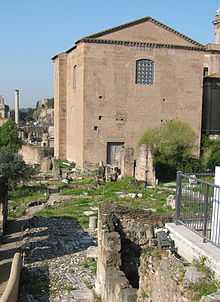Argiletum

View of the Curia Iulia, with the remains of the Argiletum, beneath Medieval layers, in the foreground.
The Argiletum was the main route approaching the Forum Romanum from the northeast.[1] It served to connect the Forum with the Subura district of the city. As it originally passed between Comitium and Basilica Pauli, the Argiletum was eventually absorbed by the construction of the imperial fora from the time of Iulius Caesar onwards. Given this encroachment, the limits of the Argiletum were defined differently in various periods. By the time of Martial the Argiletum was a seedy district filled with the taverns and brothels.[2]
Livy indicates that the temple of Ianus Geminus was located ad infimum Argiletum (Liv. 1.19.1).[3]
Varro claimed that the etymology of the term argiletum was connected with the name of a Greek scoundrel.[4]
References
- ↑ L. Richardson, jr (1 October 1992). A New Topographical Dictionary of Ancient Rome. JHU Press. pp. 39–. ISBN 978-0-8018-4300-6.
- ↑ Martial 1.2.7-8; 1.3.1; 1.117.9-12; 2.17
- ↑ Ovid; Thomas Keightley (1848). Ovid's Fasti; with introduction, notes, and excursus. By T. Keightley. Second edition ... considerably improved. Whittaker and Company. pp. 226–.
- ↑ Varro, De Lingua Latina 5.157.8 http://latin.packhum.org/loc/684/1/17/7101-7110